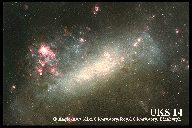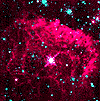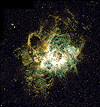- April 29th (two-topic extended class):
- ``Radiation-driven Winds in Of Stars'', Castor, Abbott, & Klein 1975, ApJ, 195, 157
- Presented by:
- Aaron Hoff and Eli Michael
- AND
- ``Atmospheric Accelerations and the Stability of Dynamic Supergiant Atmospheres'', Nieuwenhuijzen & de Jager 1995, A&A, 302, 811
- Presented by:
- Rachel Osten

MOTIVATION:
Massive, hot, OB-type stars and their descendants provide the driving force behind much of stellar formation and galactic evolution through their ionizing radiation, winds, and supernovae. A knowledge of massive stars is a necessary foundation for understanding the galactic environment and phenomena such as starbursts. Our primary goals in this course are for the students to (1) acquire an overview of the lives and global effects of massive stars via both observational and theoretical/modeling views, and (2) become acquainted with a selection of the relevant literature that they can use as starting points to pursue more specific topics.COURSE STRUCTURE:
During the first two to three classes we will present an overview of the theory, observations, evolution, and physical properties of massive stars. These classes will cover the general ideas and interrelationships between the specific topics to be covered in more detail through the semester. For the next section of the course we will assign classic or key modern papers for the students to read. Each week, one or two papers will be assigned, and two or three students will lead the in-class discussion. For subsequent classes through the rest of the semester, the students will select papers on topics related to massive stars to for the class to read and discuss.TOPICS:
Below we list an outline of the relevant topics to be discussed in this class, some in more depth than others:- Observations of massive
stars
- classification and data from different wavelength regimes
- The evolution of massive stars
- evolutionary models
- evolved types (emission, LBV, W-R)
- metallicity effects
- Massive stars, clusters, and the ecology of the galactic environment
- Selected stars and clusters
- eta Car
- 30 Doradus,
- the galactic center
Some Books/Proceedings
These books contain a number of review articles related to massive stars as well as more detailed articles on spectific topics. A good source for references to journal articles.- ``The MK Process'' 1983 (ed. Garrison)
- ``Properties of Hot Luminous Stars'' 1990 (ed. Garmany; PASP Conf. Ser. No. 7) This is the first meeting of the Boulder-Munich Workshop.
- ``Properties of Hot Luminous Stars'' 1998 This is the second Boulder-Munich Workshop. The proceedings have not been published, but you can access the papers of the presentations at http://www.star.ucl.ac.uk/~idh/HSG/BMW/TEXT.html
- ``Evolution of Massive Stars: A Confrontation between Theory and Observation'' 1994 (eds. Vanbeveren, van Rensbergen, de Loore)
- ``O Stars and Wolf-Rayet Stars'', Conti & Underhill (NASA monograph) 1988
- ``Luminous Blue Variables: Massive Stars in Transition'' 1997 (eds. Nota, Lamers; PASP Conf. Ser. No. 120)
- ``Physics of Luminous Blue Variables'' 1989 (eds. Davidson, Moffat, Lamers)
- ``The Interplay between Massive Star Formation, the ISM, and Galaxy Evolution'' 1996 (eds. Kunth, Guiderdoni, Heydari-Halayeri, Trinh Xuan Thuan)
- ``Massive Stars: Their Lives in the Interstellar Medium'' 1993 (eds. Cassinelli, Curchwell; PASP Conf. Ser. No. 35)
- ``Massive Stars in Starbursts'' 1991 (eds. Leitherer, Walborn, Heckman, Norman)
Some Articles
Below is a sample list of papers we plan to assign and/or are good for providing background and reference information for the lectures and student presentations:- ``Contemporary Optical Spectral Classification of the OB Stars: A Digital Atlas'' Walborn & Fitzpatrick, 1990, PASP, 102, 379
- ``International Ultraviolet Explorer Atlas of O-Type Spectra from 1200 to 1900 Å'' 1985, Walborn, Nichols-Bohlin, & Panek (NASA Reference Publication)
- ``International Ultraviolet Explorer Atlas of B-Type Spectra from 1200 to 1900 Å'' 1995, Walborn, Parker, & Nichols, Panek (NASA Reference Publication)
- ``K-band Spectroscopy of OB Stars: A Preliminary Classification'' Hanson & Conti 1994, ApJL, 423, L139
- ``Quantitative Spectroscopy of Hot Stars'', Kudritzki & Hummer, 1990, ARAA, 28, 303
- ``Failure of Continuum Methods for Determining the Effective Temperature of Hot Stars'' Hummer et al. 1988, ApJ, 328, 704
- ``Massive Star Populations in Nearby Galaxies'', Maeder & Conti, 1994, ARAA, 32, 227
- ``Grids of Evolutionary Models from 0.85 to 120 Solar Masses: Observational Tests and the Mass Limits'' Maeder & Meynet, 1989, A&A, 210, 155
- ``Comparative Study of Evolutionary Tracks of Massive Stars'' de Loore, 1988, A&A, 203, 71
- ``New Developments in Understanding the HR Diagram'', Chiosi, Bertelli, & Bressan, 1992, ARAA, 30, 235
- ``The Luminous Blue Variables: Astrophysical Geysers'' Humphreys & Davidson, 1994, PASP, 106, 1025
- ``Wolf-Rayet Stars in Nearby Galaxies: Tracers of the Most Massive Stars'' Massey, 1985, PASP, 97, 5
- ``Wolf-Rayet Stars'' Abbott & Conti, 1987, ARAA, 25, 113
- ``About the Initial Mass Function and He II Emission in Young Starbursts'' Schaerer, 1996, ApJ, 467, L17
- ``The Initial Mass Function and Massive Star Evolution in the OB Associations of the Northern Milky Way'' Massey et al. 1995, ApJ, 454, 151
- ``Massive Stars in the Field and Associations of The Magellanic Clouds: The Upper Mass Limit, the Initial Mass Function, and a Critical Test of Main-sequence Stellar Evolutionary Theory'' Massey et al. 1995, ApJ, 438, 188
- ``Time-Dependent Star Formation in OB Associations'' Doom, De Greve, & de Loore 1985, ApJ, 290, 185
- ``NGC 6611: A Cluster Caught in The Act'' 1993, AJ, 106, 1906
- ``The Stellar Content of LH 9 and 10 in the LMC: A Case for Sequential Star Formation'', Parker et al. 1992, The Astronomical Journal, 103, 1205
- ``Clustered Supernovae Versus the Gaseous Disk and Halo'' Heiles, 1990, ApJ, 354, 483
- ``The Peculiar Population of Hot Stars at the Galactic Center'', Tamblyn et al. 1996, ApJ, 456, 206
- ``The Nuclear Cluster of the Milky Way: Star Formation and Velocity Dispersion in the Central 0.5 Parsec'' Krabbe et al. 1995, ApJ, 447, L95
- ``Two New Wolf-Rayet Stars and a Luminous Blue Variable Star in the Quintuplet (AFGL 2004) Near the Galactic Center'', Figer, McLean, & Morris 1995, ApJ, 447, L29
- ``A Comparison of Near-Infrared Spectra of the Galactic Center Compact He I Emission-Line Sources and Early-Type Mass-Losing Stars'', Blum, DePoy, & Sellgren 1995, ApJ, 441, 603
- ``Adaptive Optics Near-Infrared Imaging of R136 in 30 Doradus: The Stellar Population of a Nearby Starburst'' Brandl et al. 1996, ApJ, 466, 245
- ``Ultraviolet Photometry of Stars in the Compact Cluster R 136 in the LMC'', Hunter et al. 1997, AJ, 113, 169
- ``The Stellar Content Of 30 Doradus Derived From Spatially Integrated Ultraviolet Spectra: A Test of Spectral Synthesis Model'' Vacca et al. 1995, ApJ, 444, 647

"Phew! That makes five hundred and one million, six hundred twenty-two thousand, seven hundred thrity-one.""Five hundred million what?" asked the little prince, "...Millions of what?"
"Millions of those little objects, " he said, "which one sometimes sees in the sky. ...Little golden objects that set lazy men to idle dreaming. As for me, I am concerned with matters of consequence. There is no time for idle dreaming in my life."
"Ah! You mean the stars?"
"Yes, that's it. The stars."
"And what do you do with five hundred millions of stars?"
--- Antoine de Saint-Exupéry
 Joel Parker
(joel@boulder.swri.edu)
Joel Parker
(joel@boulder.swri.edu)
![[SwRI Homepage]](images/small/swri2.jpg)
 Spring 1998 APS 6000 Graduate Astrophysics Seminar:
Spring 1998 APS 6000 Graduate Astrophysics Seminar:

